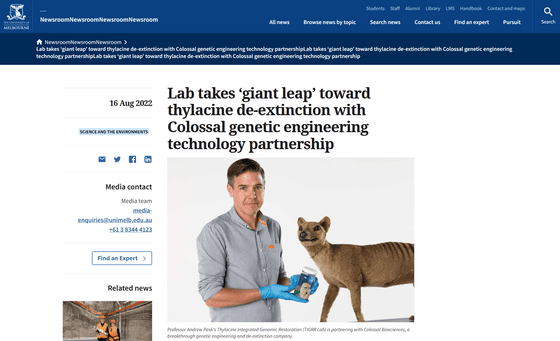A team trying to revive the owl wolf, which disappeared at the end of 1936, with gene editing technology is born

by
A company aiming to revive extinct animals using gene editing technology in a laboratory led by Andrew Pask of the University of Melbourne in order to revive the thylacine , which once lived on the island of Tasmania in Australia and is said to have been extinct in the 20th century. announced that it has partnered with Colossal Biosciences .
Lab takes 'giant leap' toward thylacine de-extinction with Colossal genetic engineering technology partnership
https://www.unimelb.edu.au/newsroom/news/2022/august/lab-takes-giant-leap-toward-thylacine-de-extinction-with-colossal-genetic-engineering-technology-partnership2

Thylacine
The thylacine, also known as the Tasmanian tiger, is a marsupial that once thrived on the Australian island of Tasmania. However, due to hunting by humans and territorial disputes with other species, the number gradually decreased, and in 1936 the last individual died in captivity and is said to be extinct.
A team led by Mr. Pask partnered with Colossal Biosciences to revive this thylacine. This will allow Mr. Pask and others to access gene editing technology that applies CRISPR , and knowledgeable scientists and companies with funds will be able to work together to revive the owl.

Because the thylacine is a relatively new and extinct species, many embryos and specimens are still preserved. In addition, the genome sequence has already been decoded, and the DNA extracted from the specimen is injected into a relatively close species to generate iPS cells , and CRISPR and other genome editing technologies are used to generate and surrogate thylacine embryos. Colossal Biosciences claims that it is possible.
“We share the same vision and passion to bring back the thylacine,” said Pask. I think we will have another baby thylacine,' he said.
Related Posts:







